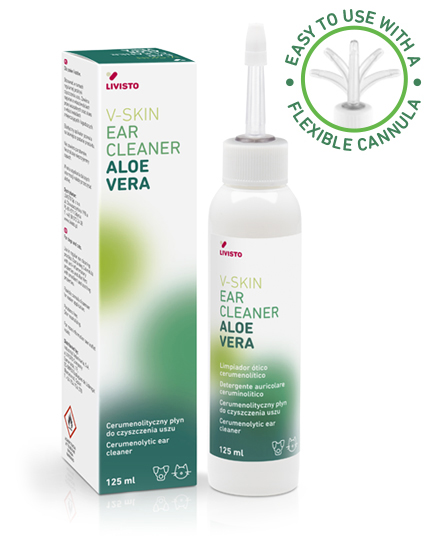EAR HYGIENE IN DOGS AND CATS
EAR HYGIENE IN DOGS AND CATS
V-SKIN
EAR CLEANER
ALOE VERA
To keep the ear canal clean and to maintain healthy microclimate.
For regular ear cleaning of your pet or as a complement in otitis treatment.
Easy to use with a flexible cannula dispenser that reduces discomfort during administration.
With a fresh hypoallergenic scent.
Parabens – free and with a pH that is appropriate to your pet´s ears.

Key points:
- Aloe Vera and Calendula: with anti-inflammatory, soothing and antibacterial properties.1, 2, 3, 4, 5, 6
- Triple cerumenolytic effect to remove wax and carefully clean the ear.
- Glycerin to moisturise the skin of the ear canal.7
When to use it:
- As a regular ear hygiene product, once or twice per week or as recommended by your veterinarian.
- As a complement to pharmacological otitis treatment to clean the ear canal. Apply 30 min before the pharmacological treatment to clean the ear. The frequency must be determined by the veterinarian.
How to use it:
- Apply a few drops to the ear canal or inner pinna while holding the ear with the other hand.
- Massage the base of the ear canal for at least 1 minute, facilitating the release of excess product and ear wax.
- Wrap a finger in clean cotton or gauze and insert it into the ear canal, taking care not to put it in too deeply, to avoid causing damage to the animal.
- Carefully rotate the finger, cleaning and drying the mixture of cleaning product and ear wax.
- Repeat this action until the cotton is clean.
- Do not use cotton buds.
- Do not use it in the case of a perforated eardrum.
Watch the product application video!
Vets' opinions
The product is very suitable for typical otitis externa along with basic therapy.The product is very gentle and easy to use

I personally had a good experience with V-SKIN Ear Cleaner in my two dogs. It has a high cleaning power, very gentle on the skin and easy to apply.

We’ve tried the ALOE VERA Ear Cleaner for regular ear hygiene in all examinations and grooming cases. We are very satisfied, as it is non-sticky, non-oily, and has a pleasant odor.

References
- Hekmatpou, D., Mehrabi, F., Rahzani, K., & Aminiyan, A. (2019). The effect of aloe vera clinical trials on prevention and healing of skin wound: A systematic review. In Iranian Journal of Medical Sciences (Vol. 44, Issue 1).
- Sánchez, M., González-Burgos, E., Iglesias, I., & Gómez-Serranillos, M. P. (2020). Pharmacological update properties of aloe vera and its major active constituents. In Molecules (Vol. 25, Issue 6).
https://doi.org/10.3390/molecules25061324 - Teplicki, E., Ma, Q., Castillo, D. E., Zarei, M., Hustad, A. P., Chen, J., & Li, J. (2018). The effects of aloe vera on wound healing in cell proliferation, migration, and viability. Wounds, 30(9).
- Tresch, M., Mevissen, M., Ayrle, H., Melzig, M., Roosje, P.; Walkenhorst, M. (2019). Medicinal plants as therapeutic options for topical treatment in canine dermatology? A systematic review. BMC Veterinary Researc, (1).
https://doi.org/10.1186/s12917-019-1854-4 - Kamr, A., Arbaga, A., El-Bahrawy, A., Elsify, A., Khaled, H., & Hassan, H. (2020). The therapeutic efficacy of Aloe vera gel ointment on staphylococcal pyoderma in dogs. Veterinary World, 13(11).
https://doi.org/10.14202/VETWORLD.2020.2371-2380 - John, R.; Jan, N. (2017). Calendula Officinalis-An Important Medicinal Plant with Potential Biological Properties. Proceedings of the Indian National Science Academy,(0).
https://doi.org/10.16943/ptinsa/2017/49126 - Chen, H. J., Lee, P. Y., Chen, C. Y., Huang, S. L., Huang, B. W., Dai, F. J., Chau, C. F., Chen, C. S., & Lin, Y. S. (2022). Moisture retention of glycerin solutions with various concentrations: a comparative study. Scientific Reports, 12(1).
https://doi.org/10.1038/s41598-022-13452-2


 We use cookies on our website to give you the most relevant experience by remembering your preferences and repeat visits. By clicking “Accept”, you consent to the use of ALL the cookies. However you may visit Cookie Settings to provide a controlled consent.
We use cookies on our website to give you the most relevant experience by remembering your preferences and repeat visits. By clicking “Accept”, you consent to the use of ALL the cookies. However you may visit Cookie Settings to provide a controlled consent.